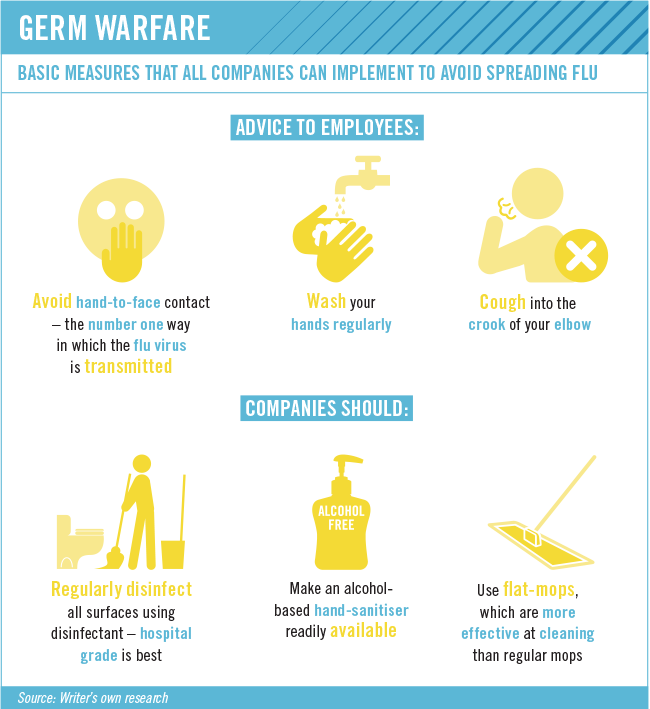Every year, absenteeism over the ‘flu season’ costs the SA economy billions. What can companies do to keep their employees – and their bottom line – fighting fit this winter?
We’re all familiar with it – the tickle in the throat, the sudden onset of fuzzy-headedness, a sneeze or two, followed by dread as the realisation sinks in… You’re getting sick. Sure, it’s hardly the most torturous thing a person can endure, but a bout of flu, or even a nasty cold, is absolutely zero fun – it’s hard to sleep, it’s hard to function, everything hurts, and no matter your age, you want your mom.
Workers facing seven days of feeling awful (the average length of a bout of flu) are also faced with a choice: to come to work, or call in sick? Depending on company culture, workload and personal work ethic, this will either result in your staying home for a day or three to rest up, or slogging in to work – infecting your colleagues and prolonging your own ill health.
Despite the stoic, if questionable commitment (prioritising work over your health is hardly commendable), this last outcome is not good news for employers. A study conducted in 2015 by the Global Hygiene Council found that the SA economy loses in excess of R2 billion each year due to absenteeism from colds and flu.
Not only do employers have to contend with employees who give in to the temptation to ‘pull a sickie’ when they are perfectly healthy (a 2017 survey of more than 1 500 South Africans across the country by Pharma Dynamics, a cold and flu medicine provider in the country, found that almost 40% were planning to fake illness over June and July to get off work), there is also the virtually unavoidable phenomenon of ill workers who come in to work and spread their infection, ratcheting up absenteeism exponentially. (Unavoidable, because people can be contagious up to two days before any symptoms develop.)
There is a common mindset among many companies and workers that coming to work when ill shows commitment and a strong work ethic, and that taking time off to recover from a cold or the flu – which are generally perceived to be ‘minor’ ailments – will reflect badly on them. And that may well be the case, but companies that encourage such attitudes are shooting themselves in the proverbial foot.
‘Many studies show that productivity levels actually only drop by about 28% when employees take sick leave, compared to a much more significant drop of 72% when they show up at work feeling lousy,’ says Pharma Dynamics communications manager Nicole Jennings.
‘With more sick employees hovering around the office, the risk of spreading viruses and making others sick increases substantially. The working sick leave behind a trail of germs on shared surfaces like stair rails, door handles, water coolers, communal fridges, counters and light switches, putting others’ health in jeopardy. Cold and flu viruses can easily spread in public spaces such as an office, and even more so when there is no proper ventilation.’
As for the notion that colds and flu are relatively harmless and can be ‘toughed out’ while continuing to work, this is a dangerous misconception. Simple rest is one of the most effective treatments for these viruses, to allow the body’s immune system maximum efficiency. Too little rest can cause the illness to linger indefinitely, or advance to complications such as sinus and ear infections, viral or bacterial pneumonia, and can exacerbate existing health problems such as heart conditions.
According to the Department of Health, the flu virus kills between 6 000 and 11 000 South Africans every year. Granted, half of those are elderly, and about 30% are HIV-positive, but even a healthy immune system can falter when the body is not allowed to rest.
According to the Department of Health, the flu vaccine is about 60% effective in healthy adults. Could it be the silver bullet for drastically reducing absenteeism? Perhaps.
‘Research in Australia has shown that vaccinated employees take fewer sick days,’ says Trudie Oates, occupational health nurse practitioner and cofounder of OccuSure. ‘There is a 43% reduction in days off work and the number of visits to the doctor reduces by approximately the same amount. In a country like South Africa, with an already failing health resource, the additional burden of winter illness patients has a profound effect on productivity and budget.’
Could employers make flu vaccination mandatory for their workers? No, says Oates. ‘Employers cannot demand employees get a flu shot, and there are contraindications to blanket vaccination. Employees need to be allowed to make an informed choice.’
It is of course still worth providing free flu vaccinations to all employees earlier in the year – March or April – after educating them on the risks and benefits. When offered free in the work environment (so employees do not have to travel to their doctor or a clinic to get the ‘jab’), the benefits look a lot more attractive and companies stand a much higher chance of protecting their workforce from infection.
Naturally, health programmes designed to educate employees on how to avoid spreading germs are equally important.
One of the best means of reducing the spread of infection is simply to make sure that employees go home to rest as soon as they begin to exhibit symptoms of infection. Managers are perfectly within their rights to do this, and, in fact, have an obligation to keep the workplace safe and healthy for other workers.
These are all short-term measures, however – a long-term strategy is just as essential. Several indirect factors – chief among them, whether your employees smoke – can contribute to an increased susceptibility to colds and flu in the workplace. Smokers are especially likely to suffer from a compromised immune system, making them far more vulnerable to respiratory infections. And their lungs and throats are more prone to inflammation, so their symptoms are more severe than those of non-smokers. All of which can add up to a higher rate of absenteeism.
According to 2012 research from the University of Nottingham, which looked at 29 separate studies conducted between 1960 and 2011 in Europe, Australia and New Zealand, smokers were 33% more likely to miss work than non-smokers, and were absent 2.7 days more per year.
Encouraging your employees to quit smoking should also form part of a longer-term health programme. By the same token, any efforts to help employees reduce stress (excessive stress is known to compromise the immune system), stay active and eat a balanced diet should have a significant impact on the overall health of the workforce, and help to reduce incidents of absenteeism across the board, whether due to colds and flu or other ailments.











